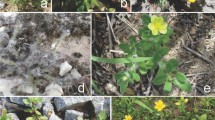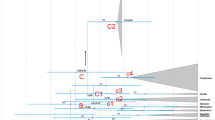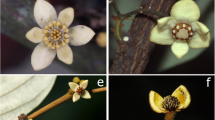Abstract
The PCK Clade, represented by six to nine genera, is a monophyletic group situated within the Paniceae tribe. The highly diverse inflorescences within the PCK Clade provide an interesting system for the study of morphological evolution and also may aid in better understanding its unclear systematics. The inflorescence structure of 110 members of the PCK Clade has been investigated. Inflorescences are polytelic showing different levels of truncation. At least 21 different inflorescence subtypes were identified. Fourteen variable inflorescence characters were found, among which some have suprageneric or infrageneric value and others are polymorphic. A key for the identification of inflorescence types is presented. Nine processes have been identified as responsible for inflorescence diversification. Highly branched inflorescences with different internode lengths are present in the basal genus whereas truncated inflorescence morphologies appear late in the history of the clade. The precise timing of morphological changes is impossible to assess until we have a well supported phylogeny for the PCK Clade.











Similar content being viewed by others
References
Aliscioni SS, Giussani LM, Zuloaga FO, Kellogg EA (2003) A molecular phylogeny of Panicum (Poaceae: Paniceae): test of monophyly and phylogenetic placement within the Panicoideae. Amer J Bot 90:796–821
Ambrose BA, Lerner DR, Ciceri P, Padilla CM, Yanofsky MF, Schmidt RJ (2000) Molecular and Genetic analyses of the silky1 gene reveal conservation in floral organ specification between eudicots and monocots. Mol Cell 5:569–579
Arriaga MO (2000) Austral South American species of Eriochloa. In: Jacobs SWL, Everett J (eds) Grasses: systematics and evolution. CSIRO, Melbourne, pp 141–148
Beauvois P (1812) Urochloa. Essai d’une Nouvelle Agrostographie 11: 52
Bess EC, Doust AN, Kellogg EA (2005) A naked grass in the “Bristle Clade”: A phylogenetic and developmental study of Panicum section Bulbosa (Paniceae: Poaceae). Int J Pl Sci 166:371–381
Bommert P, Lunde C, Nardmann J, Vollbrecht E, Running M, Jackson D, Hake S, Werr W (2005) thick tassel dwarf1 encodes a putative maize ortholog of the Arabidopsis CLAVATA1 leucine-rich repeat receptor-like kinase. Development 132:1235–1245
Buzgo M, Soltis DE, Soltis PS, Ma H (2004) Towards a comprehensive integration of morphological and genetic studies of floral development. Trends Pl Sci 9:164–173
Cámara Hernández J (2001) Morfología de la inflorescencia de Digitaria sanguinalis (L.) Scop. (Poaceae). Bol Soc Argent Bot 36:87–95
Cámara Hernández J, Rua GH (1991) The synflorescence of Poaceae. Beitr Biol Pflanz 66:297–311
Cámara Hernández J, Miante-Alzogaray A (1994) Polytely: a general character in Poaceae. Beitr Biol Pflanz 68:249–261
Chuck G, Meeley R, Hake S (1998) The control of maize spikelet meristem identity by the APETALA-2 like gene indeterminate spikelet1. Genes Dev 12:1145–1154
Chuck G, Muszynski M, Kellogg EA, Hake S, Schmidt RJ (2002) The control of spikelet meristem identity by branched silklees1 gene in maize. Science 298:1238–1241
Clayton WD, Renvoize SA (1982) Flora of Tropical East Africa: Gramineae, part 3. A. A Balkema, Rotterdam, pp 451–898
Clayton WD, Renvoize SA (1986) Genera graminum: grasses of the world. Kew Bull, Add Ser 13:1–389
Davidse G (1987) Fruit dispersal in the Poaceae. In: Soderstrom TR, Hilu KW, Campbell CS, Barkworth ME (eds) Grass systematics and evolution. Smithsonian Inst. Press, Washington, pp 143–155
Davidse G (1993) Poaceae. In: Brako L, Zarucchi JL (eds) Catalogue of the flowering plants and gymnosperms of Peru. Monogr Syst Botany Missouri Botanical Garden 45:1258
Doebley J, Stec A, Hubbard L (1997) The evolution of apical dominance in maize. Nature 386:485–488
Doust AN, Kellogg EA (2002a) Integrating phylogeny, developmental morphology and genetics: a case study of inflorescence evolution in the “bristle grass” clade (Panicoideae: Poaceae). In: Cronk QCB, Bateman RM, Hawkins JA (eds) Developmental genetics and plant evolution. Taylor and Francis, London, pp 298–314
Doust AN, Kellogg EA (2002b) Inflorescence diversification in the panicoid “bristle grass” clade (Paniceae, Poaceae): evidence from molecular phylogenies and developmental morphology. Amer J Bot 89:1203–1222
Doust AN, Drinnan AN (2004) Floral development and molecular phylogeny support the generic status of Tasmannia (Winteraceae). Amer J Bot 91:321–331
Doust AN, Devos KM, Gadberry MD, Gale MD, Kellogg EA (2005) The genetic basis for inflorescence variation between foxtail and green millet (Poaceae). Genetics 169:1659–1672
Duvall MR, Noll JD, Minn AH (2001) Phylogenetics of Paniceae (Poaceae). Amer J Bot 88:1988–1992
Frank L (1998) Análisis del sistema de ramificación del complejo Brachiaria-Urochloa (Poaceae–Paniceae), Tesis. Universidad de Buenos Aires, Buenos Aires
Fraser JE, Kokko G (1993) Panicle, spikelet, and floret development in orchard grass (Dactylis glomerata). Canad J Bot 71:523–532
Friedman J, Harder LD (2005) Functional associations of floret and inflorescence traits among grass species. Amer J Bot 92:1862–1870
Gallavotti A, Zhao Q, Kyozuka J, Meeley RB, Ritter MK, Doebley JF, Pe ME, Schmidt RJ (2004) The role of barren stalk1 in the architecture of maize. Nature 432:630–635
Giraldo-Cañas D (2000) Estudios sobre la variación estructural de la sinflorescencia en el género Axonopus (Poaceae, Panicoideae, Paniceae): Tipología y tendencias evolutivas. Darwiniana 38:209–218
Giussani LM, Cota-Sánchez JH, Zuloaga FO, Kellogg EA (2001) A molecular phylogeny of the grass subfamily Panicoideae (Poaceae) shows multiple origins of C4 photosynthesis. Amer J Bot 88:1935–1944
Goebel K (1931) Blütenbildung und Sproßgestaltung. 2 Erg. Bd. zur Organographie der Pflanzen. Jena. Fide Butzin (1979)
Gómez-Martinez R, Culham A (2000) Phylogeny of the subfamily Panicoideae with emphasis on the tribe Paniceae: evidence from the trnL-F cpDNA region. In: Jacobs SWL, Everett J (eds) Grasses: systematics and evolution. CSIRO, Melbourne, pp 136–140
Grass Phylogeny working Group (2001) Phylogeny and subfamilial classification of the grasses (Poaceae). Ann Missouri Bot Gard 88:373–457
Grisebach AHR (1853) Brachiaria. In: Ledebour FK (ed) Fl. Ross. Sumtibus Librariae E. Schweizerbart, Stuttgartiae, vol 4, pp 469
Henrard JT (1941) Notes on the nomenclature of some grasses. Blumea 3:411–480
Hughes DK (1923) The genus Panicum of the Flora Australiensis. Kew Bull Miscel Inform 9:305–314
Ikeda K, Sunohara H, Nagato Y (2004) Developmental course of inflorescence and spikelet in rice. Breed Sci 54:147–156
Irish EE (1998) Grass spikelets: a thorny problem. BioEssays 20:789–793
Jacobs BF, Kingston JD, Jacobs II (1999) The origin of grass-dominated ecosystems. Ann Missouri Bot Gard 86:590–643
Kellogg EA (2000) Molecular and morphological evolution in the Andropogoneae. In: Jacobs SWL, Everett J (eds) Grasses: systematics and evolution. CSIRO, Collingwood, pp 149–158
Kellogg EA, Hiser KM, Doust AN (2004) Taxonomy, phylogeny and inflorescence development of the genus Ixophorus (Panicoideae: Poaceae). Int J Pl Sci 165:1089–1105
Kunze H (1989) Probleme der Infloreszenztypologie von W. Troll Pl Syst Evol 163:187–199
Liu Q, Zhao NX, Hao G (2005) Inflorescence structures and evolution in subfamily Chloridoideae (Gramineae). Pl Syst Evol 251:183–198
López-Ferrari AR, Espejo Serna A (2000) Nuevas combinaciones en monocotiledóneas mexicanas III (Orchidaceae, Poaceae). Acta Bot Mex 51:61–70
Malcomber ST, Preston JC, Reinheimer R, Kossuth J, Kellogg EA (2006) Developmental gene evolution and the origin of grass inflorescence diversity. Adv Bot Res 44:425–481
Maresquelle HJ (1970) Le teme évolutif des complexes d′inflorescence. Son aptitude à suscite des problèmes nouveaux. Bull Soc bot Fr 117:1–4
Morrone O, Zuloaga FO (1991) Estudios morfológicos en el subgénero Dichanthelium de Panicum (Poaceae), con especial referencia a Panicum sabulorum. Ann Missouri Bot Gard 78:915–927
Morrone O, Zuloaga FO (1992) Revisión de las especies Sudamericanas nativas e introducidas de los géneros Brachiaria y Urochloa (Poaceae: Panicoideae: Paniceae). Darwiniana 31:43–109
Morrone O, Zuloaga FO (1993) Sinopsis del género Urochloa (Poaceae: Panicoideae: Paniceae) para Mexico y América Central. Darwiniana 32:59–75
Morrone O, Zuloaga FO, Arriaga MO, Pozner R, Aliscioni SS (1998) Revisión sistemática y análisis cladístico del género Chaetium (Poaceae: Panicoideae: Paniceae). Ann Missouri Bot Gard 85:404–424
Nash G.V. (1903) Brachiaria. In: Small J.K. (ed) Flora of the Southeastern United States, pp. 80–81. New York
Nelson SCH, Fernández CFJ (1998) De Xora hondurensi notulae, praecipue nomenclaturales. Fontqueria 51:3–4
Nicora EG, Rúgolo de Agrasar ZE (1987) Los géneros de gramíneas de América Austral. Hemisferio Sur, Buenos Aires, Argentina
Pensiero JF, Vegetti AC (2001) Inflorescence typology in Setaria P. Beauv. (Poaceae, Paniceae). Feddes Repert 112:371–385
Perreta M, Vegetti AC (1998) Tipologia de la inflorescencia en Leptochloa chloridiformis, Leptochloa virgata y Leptochloa mucronata (Poaceae). Kurtziana 26:135–144
Poeting R (1990) Phase change and the regulation of shoot morphogenesis in plants. Science 250:923–930
Reinheimer R (2007) Desarrollo y estructura de la inflorescencia de Brachiaria y Urochloa (Poaceae: Panicoideae: Paniceae) y sus implicancias sistemáticas. Tesis Doctoral Fac Bioq Cs Biol–UNL.
Reinheimer R, Vegetti AC (2004) The inflorescence of South American species of Panicum subg. Phanopyrum sect. Laxa (Poaceae: Panicoideae:Paniceae). Beitr Biol Pflanz 73:185–199
Reinheimer R, Pozner R, Vegetti AC (2005) Inflorescence, spikelet and floral development in Panicum maximum and Urochloa plantaginea (Poaceae). Amer J Bot 92:565–575
Renvoize SA, Clayton WD (1992) Classification and evolution of the grasses. In: Chapman JP (ed) Grass evolution and domestication. Cambridge University Press, Cambridge, pp 3–37
Rua GH (1993) The synflorescence of Paspalidium rarum (Poaceae) and an alternative hypothesis about the evolution of some poaceous inflorescences. Austral Syst Bot 6:261–267
Rua GH (1996) The inflorescences of Paspalum (Poaceae, Paniceae): the Quadrifaria group and the evolutionary pathway towards the fully homogenized, truncated common type. Pl Syst Evol 201:199–209
Rua GH (1999) Inflorescencias: bases teóricas para su análisis. Sociedad Argentina de Botánica, Buenos Aires, Argentina
Rua GH (2003a) Centothecoid grasses and the evolution of panicoid spikelets. Pl Syst Evol 240:83–89
Rua GH (2003b) Growth forms, branching patterns, and inflorescence structure in Digitaria sect. Trichachne (Poaceae, Paniceae). Flora 198:178–187
Rua GH, Boccaloni IB (1996) The inflorescence of Digitaria phaeotrix: morphological and developmental aspects. Flora 191:117–119
Rua GH, Weberling F (1998) Growth form and inflorescence structure of Paspalum L. (Poaceae: Paniceae): a comparative morphological approach. Beitr Biol Pflanz 69:363–431
Schmidt RJ, Ambrose BA (1998) The blooming of grass flower development. Curr Opinion Plant Biol 1:60–67
Sell Y (1976) Tendances évolutives parmi les complexes inflorescentiels. Rev Gen Bot 83:247–267
Sharp D, Simon BK (2002) AusGrass (CD ROM): grasses of Australia. CSIRO Publishing, Victoria
Shaw RB, Smeins FE (1984) Additional observations of the callus in Eriochloa (Poaceae). Iselya 2:15–19
Simon BK, Jacobs SWL (2003) Megathyrsus, a new generic name for Panicum subgenus Megathyrsus. Austrobaileya 6:571–574
Soreng RJ, Davis JI (1998) Phylogenetics and character evolution in the grass family (Poaceae): simultaneous analysis of morphological and chloroplast DNA restriction site character sets. Bot Rev 64:1–84
Stapf O (1914–1932) Gramineae. In: Oliver D (ed) Flora of Tropical Africa. Lowell Reeve and Co, London, pp 1–192
Stür WW (1986) Reproductive development of the apex of Brachiaria decumbens Stapf. Ann Bot 58:569–575
Taguchi-Shiobara F, Yuan Z, Hake S, Jackson D (2001) The fascinated ear2 gene encodes a leucine-rich repeat receptor-like protein that regulates shoot meristem proliferation in maize. Genes Dev 15:2755–2766
Takahashi M, Nagasawa N, Kitano H, Nagato Y (1998) Panicle phytomer1mutations affect panicle architecture of rice. Theor Appl Genet 96:1050–1056
Thompson RA, Tyrl RJ, Estes JR (1990) Comparative anatomy of the spikelet callus of Eriochloa, Brachiaria and Urochloa (Poaceae, Paniceae, Setariineae). Amer J Bot 77:1463–1468
Torres González AM, Morton CM (2005) Molecular and morphological phylogenetic analysis of Brachiaria and Urochloa (Poaceae). Molec Phylogenet Evol 37:36–44
Trinius CB (1826) De Graminibus paniceis: Disertatio botanica altera. 125–153. Petropoli, Impendis Academiae Imperialis Scientiarum, St Petersburg
Troll W (1964) Die Infloreszenzen, Typologie und Stellung im Aufbau des Vegetationskörpers 1. Gustav Fischer, Jena
Troll W (1966) Botanischer Teil. In: Kommission für biologische Forschung, 110–131, Bericht. Jb. 1965. Akademie der Wissenschaften und der Literatur, Mainz
Troll W (1969) Botanischer Teil. In: Kommission für biologische Forschung, 88–105, Bericht. Jb. 1968. Akademie der Wissenschaften und der Literatur, Mainz
Troll W, Weberling F (1989) Infloreszenzuntersuchungen an monotelen Familien. G. Fischer, Stuttgart
Tzvelev NN (1989) The system of grasses (Poaceae) and their evolution. Bot Rev 55:141–204
Vegetti AC (1987) Analisis tipológico de las inflorescencia en Paspalum (Poaceae). Kurtziana 19:155–160
Vegetti AC (1991a) Sobre politelia en las inflorescencias de Poaceae. Kurtziana 21:267–274
Vegetti A (1991b) Notes on Monotely in Poaceae inflorescences. Beitr Biol Pflanzen 66:347–350
Vegetti AC (1999) Typology of the Synflorescence of Andropogoneae (Poaceae), additional comments. Feddes Repert 110:111–126
Vegetti AC (2000) Typology of synflorescence in Oryzeae (Poaceae). Phyton (Austria) 40:71–88
Vegetti AC, Pensiero JF (1990) Inflorescence typology in Setaria poiretiana (Schultes) Kunth (Poaceae: Paniceae). Beitr Biol Pflanz 65:313–318
Vegetti AC, Anton AM (1995) Some evolution trends in the inflorescence of Poaceae. Flora 190:225–228
Vegetti AC, Pensiero JF (1999) Tipología de la inflorescencia en Zizaniopsis (Oryzeae–Poaceae). Darwiniana 37:345–349
Vegetti AC, Anton AM (2000) The Grass Inflorescence. In: Jacobs SWL, Everett J (eds) Grasses: systematics and evolution. CSIRO, Melbourne, pp 29–31
Vegetti AC, Müller-Doblies D (2004) The inhibition areas within the synflorescence of Poaceae. Beitr Biol Pflanz 73:51–74
Veldkamp JF (1996a) Proposal to conserve the name Brachiaria (Trin.) Griseb. (Gramineae) with a conserved type. Taxon 45:319–320
Veldkamp JF (1996b) Brachiaria, Urochloa (Gramineae-Paniceae) in Malaysia. Blumea 41:413–437
Veldkamp JF (2004) Miscellaneous notes on mainly Southeast Asian Gramineae. Reinwardtia 12:135–140
Vollbrecht E, Reiser L, Hake S (2000) Shoot meristem size is dependent on inbred background and presence of the maize homeobox gene, knotted1. Development 127:3161–3172
Vollbrecht E, Springer PS, Goh L, Buckler Iv ES, Martienssen R (2005) Architecture of the floral branch systems in maize and related grasses. Nature 436:1119–1126
Walsh J, Freeling M (1999) The liguleless2 gene of maize functions during the transition from vegetative to reproductive shoot. Pl J 19:489–495
Watson L, Dallwitz MJ (1992) The grass genera of the world. C.A.B. International, Wallingford, UK
Weberling F (1965) Typology of inflorescences. Bot J Linn Soc 59:15–221
Weberling F (1985) Aspectos modernos de la morfología de las inflorescencias. Bol Soc Argent Bot 24:1–28
Weberling F (1989) Morphology of flowers and inflorescences. Cambridge University Press, Cambridge
Webster RD (1987) The Australian Paniceae (Poaceae). J Cramer, Berlin and Stuttgart, Germany, pp 228–255
Webster RD (1988) General of the North American Paniceae (Poaceae: Panicoideae). Syst Bot 13:576–609
Zizka G (1988) Revision der Melinideae Hitchcock (Poaceae, Panicoideae). Bibl Bot 138:1–149
Zuloaga FO, Morrone O (2003) Brachiaria, Urochloa. In: Zuloaga FO, Morrone O, Davidse G, Filgueiras TS, Peterson PM, Soreng RJ, Judziewicz EJ (eds) Catalogue of new world grasses (Poaceae): III. Subfamilies Panicoideae, Aristidoideae, Arundionoideae and Danthonioideae, Contribution from the United State National Herbarium, vol 46, pp 1–662
Zuloaga FO, Morrone O, Giussani LM (2000) A cladistic analysis of the Paniceae: a preliminary approach. In: Jacobs SW, Everett J (eds) Grass: systematics and evolution. CSIRO Publishing, Collingwood, pp 123–135
Acknowledgments
The authors thank Elizabeth A. Kellogg and two anonymous reviewers for critical reading of the manuscript and for her helpful comments. We also are grateful to Osvaldo Morrone and CIAT for access to plant materials of Urochloa lata. Financial support was provided by UNL - CAID + D 2006 (to R.R.), UNL-CAID + D 2002 (to A.V) and PIP-CONICET 2935/00 (to A.V).
Author information
Authors and Affiliations
Corresponding author
Rights and permissions
About this article
Cite this article
Reinheimer, R., Vegetti, A.C. Inflorescence diversity and evolution in the PCK Clade (Poaceae: Panicoideae: Paniceae). Plant Syst Evol 275, 133–167 (2008). https://doi.org/10.1007/s00606-008-0057-4
Received:
Accepted:
Published:
Issue Date:
DOI: https://doi.org/10.1007/s00606-008-0057-4




